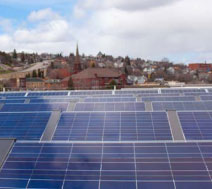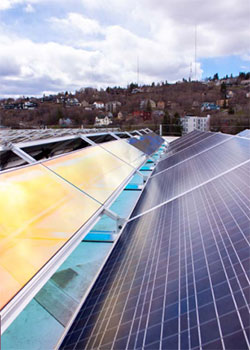Minnesota Power partners on solar project with St. Louis County and NRRI
 Solar panels from three manufacturers are quietly producing energy on the roof of St. Louis County’s Government Services Center (GSC). These side-by-side installations are part of a unique solar research partnership. The GSC has been undergoing major renovations to become more energy efficient. Within this overall energy improvement initiative, the county plans to seek LEED certification for the building, recognizing significant and integrated efficiency gains and also requiring some generation of renewable energy on site. The desire for renewable energy led to the plan to install photovoltaic (PV) electrical energy generating systems on the building’s roof and with that the conception of a simultaneous research project on solar panel technology using the GSC site.
Solar panels from three manufacturers are quietly producing energy on the roof of St. Louis County’s Government Services Center (GSC). These side-by-side installations are part of a unique solar research partnership. The GSC has been undergoing major renovations to become more energy efficient. Within this overall energy improvement initiative, the county plans to seek LEED certification for the building, recognizing significant and integrated efficiency gains and also requiring some generation of renewable energy on site. The desire for renewable energy led to the plan to install photovoltaic (PV) electrical energy generating systems on the building’s roof and with that the conception of a simultaneous research project on solar panel technology using the GSC site.
Together, the three 10,000-watt systems are part of a multi-year research project on solar energy performance and durability in a northern climate. The collaborators in the project—Minnesota Power, St. Louis County and the University of Minnesota-Duluth’s Natural Resources Research Institute, or NRRI—are looking for answers to questions like these:
- How do snow, low winter sun angles, cloud cover and humidity affect electrical output in these photovoltaic systems?
- How durable are the units when faced with days of bitter cold temperatures?
- What is the relative performance of panels both near and long term?
- Are there lessons learned about installation methods and procedures that can be translated to other projects and do they vary significantly from one product to another?
- What units work best under what conditions and what kind of maintenance do they need?
 The solar panels were installed on the rooftop in downtown Duluth beginning in late 2013 and unveiled to the public in February 2014. They were made by Silicon Energy, based in Mountain Iron, Minn., TenKsolar in Bloomington, Minn., and Trina, a Chinese manufacturer. NRRI will monitor the amount of energy generated from each system along with other performance, environmental conditions, and weather parameters. Matt Mlinar, NRRI research coordinator, said data collection is expected to begin this summer.
The solar panels were installed on the rooftop in downtown Duluth beginning in late 2013 and unveiled to the public in February 2014. They were made by Silicon Energy, based in Mountain Iron, Minn., TenKsolar in Bloomington, Minn., and Trina, a Chinese manufacturer. NRRI will monitor the amount of energy generated from each system along with other performance, environmental conditions, and weather parameters. Matt Mlinar, NRRI research coordinator, said data collection is expected to begin this summer.
"This project will be both a qualitative and quantitative study of the impacts that renewable energy systems like solar photovoltaic can have in a community,” Mlinar said. “What are the environmental and economic impacts locally, and how well do solar photovoltaic systems perform in a northern Minnesota climate? We hope the results will serve as a road map for solar photovoltaic power applications in future residential and community projects."
Minnesota Power, which provided significant funding for the project, will be able to use insights gained from the research as part of its ongoing effort to provide educational resources for customers about solar installations and serve as a demonstration project for other government agencies, businesses and homeowners considering a move to solar power. The research will provide valuable supplemental information to existing solar studies from around the nation by using region-specific results.
"This is a great collaborative effort that, in the end, will save energy and save money for our taxpayers."
Tony Mancuso,
Property Management Director, St. Louis County
"This is a great collaborative effort that, in the end, will save energy and save money for our taxpayers,” said Tony Mancuso, property management director for St. Louis County.
"We are thankful to have great community partners like Minnesota Power and NRRI. When this study is complete, St. Louis County will keep the solar panels, which together can generate approximately 30,000 watts of electricity."
The rooftop setup is similar to the types of systems that will help Minnesota Power reach the state-mandated goal of generating 1.5 percent of its electricity from solar power by 2020.
Visit solar.mnpower.com to see the latest updates on this research.


